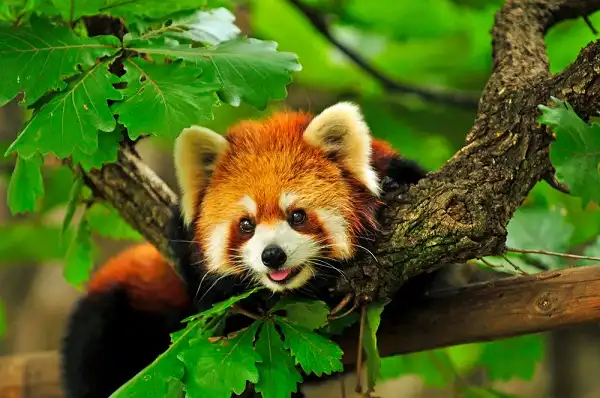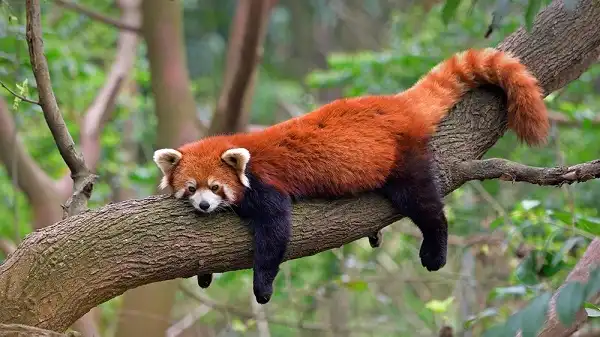Red pandas are among the most beloved animals in the world. They have a unique appearance, with their distinctive rusty red fur and black-and-white markings that make them instantly recognizable. Not only are these mammals incredibly cute, but they also play an essential role in sustaining healthy Himalayan forest ecosystems. In this blog post, we will explore why red pandas are important to both biodiversity and human communities alike — from their conservation status to the huge potential for ecotourism opportunities — and how each of us can help protect them for generations to come.

Red Panda Description
The red panda, also known as the lesser panda, is a small arboreal mammal native to the eastern Himalayas and southwestern China. It is the only species of the genus Ailurus, and its closest living relative is the giant panda. Despite their name, red pandas are not closely related to giant pandas, and they are not bears at all. They are actually part of the family Ailuridae, which is closely related to raccoons and skunks. The red panda’s distinctive red fur is well-suited to its habitat in the dense understory of the Himalayan forests. Its thick fur insulates it from cold temperatures, and its dark markings provide camouflage against predators. In addition to their ecological importance, red pandas also have significant cultural and economic value. They have been featured in many traditional art forms in their native range, such as embroidery, painting, and opera. They also have the potential to be a major driver of ecotourism in the region, as travelers from around the world seek out opportunities to see these unique and adorable animals in the wild.
Red Panda Habitat
Red pandas are found in the eastern Himalayas and southwestern China, where they inhabit forested areas with dense bamboo undergrowth. They prefer altitudes between 1,800 and 4,800 meters and can be found in both temperate and subtropical forests. These forests provide them with the ideal habitat for their omnivorous diet and other essential needs. The red panda’s habitat is crucial to maintaining healthy Himalayan forest ecosystems, which are some of the most biodiverse and threatened ecosystems in the world. These forests provide essential ecosystem services, such as protecting watersheds, preventing soil erosion, and regulating the climate.
The red panda plays an essential role in maintaining the balance and health of these ecosystems, as they help to disperse seeds and maintain the bamboo understory that is critical to the survival of many other species. However, the red panda’s habitat is under threat from several factors, including deforestation, habitat fragmentation, agricultural encroachment, and climate change. Human activities are causing significant damage to the red panda’s habitat, threatening its survival and the health of the entire ecosystem. Protecting the red panda’s habitat is crucial to ensuring the survival not only of this endemic species but also of the broader Himalayan ecosystem and the communities that depend on it.
Red Panda Diet
The red panda’s diet is predominantly herbivorous, with bamboo making up the bulk of its food intake. However, they also supplement their diet with fruits, acorns, roots, and eggs. They are known to have a very selective diet, preferring the youngest and most tender bamboo shoots, and will often choose shoots that are higher in nutrients and lower in toxins. In addition to bamboo, the red panda’s diet also includes a variety of other plant species, such as berries, mushrooms, and grasses. Some studies suggest that they may also consume small rodents, insects, and occasionally bird eggs, as a source of protein. The red panda’s dietary preferences and feeding behavior play a crucial role in maintaining the balance and health of the forest ecosystem. Through their selective feeding, they promote the growth of new, tender bamboo shoots, which are more palatable to other herbivorous animals and thus provide food for a variety of animal species, including some endangered ones.
Red Panda Size
Red pandas, also known as lesser pandas, are small arboreal mammals that are native to the eastern Himalayas and southwestern China. They are roughly the size of a domestic cat and have a distinctive reddish-brown fur coat with white markings on their face, belly, and tail. On average, adult red pandas weigh between 3 and 6 kg (6.6 to 13.2 lbs) and measure between 50 and 64 cm (20 to 25 inches) in length, with an additional 30 to 47 cm (12 to 19 inches) of the tail. Females are typically smaller than males, with a body weight that ranges between 3 and 4 kg (6.6 to 8.8 lbs).

Red Panda Lifespan
The lifespan of red pandas is an interesting and important topic as it contributes to understanding their ecology and conservation. While there is limited information on the average lifespan of wild red pandas, it is estimated to be between 8-10 years, with some individuals living up to 15 years. In captivity, red pandas have been known to live up to 20 years. The red panda’s lifespan is influenced by various factors, including genetics, environmental conditions, and human activities. Like many species, red pandas face threats from habitat loss, poaching, and climate change. These threats can impact their survival and reduce their lifespan. Additionally, zoos and captive breeding programs have played a crucial role in preserving the genetic diversity of red pandas and providing a safe haven for the species. The captive breeding of endangered red pandas has helped to support the increase in population density, a vital aspect of species conservation. The lifespan of red pandas is influenced by various factors, including genetics, environmental conditions, and human activities.
Red Panda Behavior
Red pandas are known for their unique and fascinating behaviors. Despite their small size, they are highly intelligent and adaptable animals, capable of exhibiting a wide range of complex behaviors. In the wild, red pandas are primarily solitary creatures, spending much of their time foraging for food and resting in trees. They are nomadic by nature, wandering through their forest habitat in search of bamboo shoots, berries, and small insects. When they do encounter other red pandas, they communicate through a series of vocalizations, including whistles, grunts, and squeaks, as well as through scent markings. Red pandas are also known for their agile and acrobatic abilities. They are expert climbers, using their sharp claws and long tails to ascend trees and move effortlessly through the forest canopy. They are able to jump long distances from tree to tree and are adept at balancing on narrow branches. One unique behavior of red pandas is their habit of sleeping in trees. They will often curl up high in the branches, wrapping their tail around themselves for warmth and protection. This behavior not only helps them to avoid predators on the forest floor but also allows them to conserve energy by limiting their exposure to the elements.
Red Panda Speed
Red pandas may not be known for their speed, but they are still formidable runners and climbers. In fact, they are able to run at speeds of up to 30 miles per hour, which is incredibly fast for a creature their size! Their quick movements allow them to evade predators like leopards and snow leopards in the wild. These agile animals are also able to climb trees with lightning speed. Their sharp claws and long tails give them excellent grip, allowing them to ascend trees in a matter of seconds. Red pandas are also great at leaping from tree to tree. Their lightweight bodies and long tails give them excellent balance and allow them to traverse long distances in the blink of an eye. They are even able to jump up to 6 feet in the air, making them adept at avoiding obstacles in their path.

Red Panda Hunting
The red panda, with its striking reddish-brown fur and expressive eyes, is a captivating sight for any animal enthusiast. Though predominantly herbivores, red pandas are known to indulge in small mammals, eggs, and insects on rare occasions. Their hunting behavior is rather opportunistic, as they rely primarily on their acute senses and agile skills to locate and pursue prey. Red pandas have sharp senses of smell and hearing, which they use to detect any nearby threat or potential prey. They have an excellent sense of balance and coordination, which enables them to move with precision and agility through the trees. These skills are vital when hunting, especially when they need to stalk their prey, creep up on it silently, and pounce for the kill. While hunting, a red panda’s speed and agility come into play, making them formidable predators despite their small size. They can move quickly and silently through the trees, leaping from branch to branch with ease. Furthermore, their prehensile tails allow them to maintain their balance while moving, giving them an advantage over their prey. Red pandas are primarily nocturnal animals, and they hunt mostly at night. During the day, they are more likely to rest and conserve their energy, but they will still forage for small prey if they come across it. In the wild, a red panda’s diet may include small rodents, such as mice and rats, as well as birds and their eggs, small reptiles, and insects.
Red Panda Reproduction and Lifecycle
Red pandas are solitary creatures, but they come together to mate during the breeding season. Female red pandas reach sexual maturity at around 18 months, while males become sexually mature after about 2 years. They usually breed between January and March, and the female begins ovulating several days before mating starts. Gestation lasts for around 100 to 130 days. When the cubs are born, they are incredibly small and helpless, weighing only 60-120 grams each. They remain in their nest during the first few weeks of life, relying on their mother for food and warmth until they’re about three months old. At this point, they begin leaving the nest and exploring their surroundings with their mother. Cubs stay with their mothers until they reach one year of age, at which point they become independent and start living on their own.
Threats to Red Pandas: Conservation Efforts and Challenges
Red pandas are currently listed as “vulnerable” on the International Union for Conservation of Nature (IUCN) Red List, meaning their population is decreasing and they may face extinction in the near future. The primary threats to red pandas include habitat loss and fragmentation due to deforestation, poaching, climate change, competition with livestock for food resources, and human disturbances such as tourism. Fortunately, there are several conservation initiatives underway that aim to preserve and protect red panda populations around the world. These efforts include habitat restoration projects, anti-poaching campaigns, captive breeding programs, legal protection from hunting or other activities that endanger these animals, public awareness campaigns about the importance of preserving red panda habitats, and more. Despite these efforts, there are still many challenges that need to be addressed if we are to ensure the long-term survival of red pandas. These include developing better monitoring systems and improving enforcement of conservation laws, reducing human disturbances in critical habitats, mitigating climate change impacts on red pandas, creating more effective education programs on red panda conservation, and increasing funding for research and conservation initiatives.

Conclusion
Red pandas are truly fascinating animals. Their unique physical features and behaviors enable them to move with agility and speed in their natural habitat, whether they’re foraging for food or hunting prey. Thanks to their sharp senses, strong grip, and extraordinary balance and coordination, they can navigate their environment with ease. Red pandas are also surprisingly quick on their feet, allowing them to catch up to their prey even when it runs away. Overall, red pandas are incredible creatures that deserve our protection so future generations can appreciate their beauty and enjoy watching them in the wild. We must do everything we can to ensure these majestic animals survive for many years to come.
Frequently Asked Question

